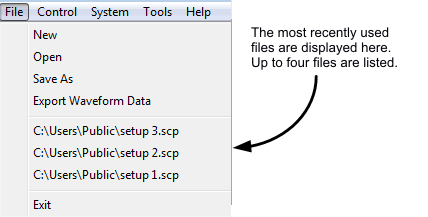
Click an icon or a command in the menus shown below to view its description.


Sets the software to its standard initial state using the current hardware configuration. The window name changes to Untitled. Rename and save the new setup as a settings (.scp) file (saving only the software parameters) or a GZIP format compressed settings file (.scpz).

Opens a saved settings (.scp) or compressed settings (.scpz) file. Opening a settings file configures the waveform data parameters for use with the currently selected hardware.
To use a settings file with a different hardware configuration, select Change Hardware Connections or Run System Configuration Wizard and re-configure the hardware.

Saves the parameters configured in the Waveform Setup node and Instrument node to a specified settings file (.scp) or a GZIP format compressed settings file (.scpz). Settings files do not include the hardware configuration information such as LAN or GPIB settings for specific instruments listed in the Hardware node.
Saves an encrypted waveform file (with a .wfm extension) to your PC. The file includes the settings and parameters from the Waveform Setup and Carrier nodes. This waveform file can then be downloaded and played in other licensed instruments or used with Keysight Advanced Design System (ADS) wireless libraries.
Do not use spaces in the file name for an exported waveform. The underscore character is allowed.
Refer to your signal generator's Programming Guide for information about downloading waveform files to your instruments.
This area of the menu displays the four most recent settings files that were opened with Open or saved with Save As. The settings file used most recently is added to the top of the list. Deleting a settings file does not immediately remove it from the list. Selecting a deleted settings file displays an error and then removes the file from the list.

If you have changed hardware parameters, but have not changed waveform setup parameters, you are not prompted to save changes when closing or exiting the software.
Stops and closes the software. The close window button  performs the same function as selecting .
performs the same function as selecting .
Opens the Preference dialog box in which you can turn determine which carrier versions to display. The carrier types that you turn in the Preference dialog box are not displayed in the drop-down lists of available carriers as shown below.

Generates a waveform. Use this function to check for waveform errors before downloading or exporting the waveform.

Generates and downloads a waveform to the connected instrument(s).
When a power-sensitive DUT is connected to the instrument, ensure that the RF power is off before downloading a waveform.
Opens  Step 2 of the System Configuration Wizard,
where you can select a previously saved hardware configuration, or define
and save a new hardware configuration.
Step 2 of the System Configuration Wizard,
where you can select a previously saved hardware configuration, or define
and save a new hardware configuration.
Enables you to configure your system component connections and save the hardware configuration for later use. Use the System Configuration Wizard to set up a new instrument connection.
enables or disables the  welcome
dialog
display.
welcome
dialog
display.
opens the help system and displays the table of contents. You can also use the F1 key.
opens the Help system and displays the search utility.
opens a help system for the API programming commands and their descriptions.
displays a description of the licensing terms agreement for Keysight's Signal Studio software.
opens a webpage of all the Signal Studio products and their available options.